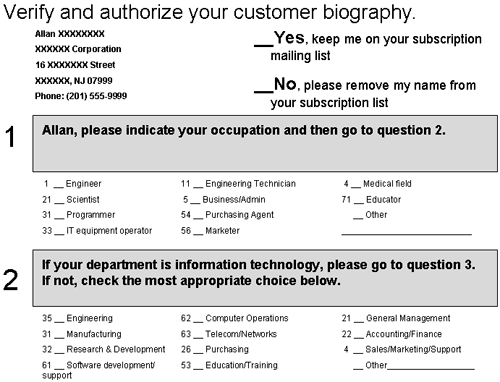20.5. Using Tools to Manage Data
We've already mentioned several of the external sources for improving data quality, but there are many more ways of verifying and validating the customer information we have captured in our files.
20.5.1. Measuring Data Quality
The basic method of measuring data quality for both the baseline and final result involves selecting a random sample of target customers from the target database and examining each of the elements (or sets of elements) as to whether it passes the criteria shown in Table 20-7.
| Component | Definition | How to Measure |
|---|---|---|
| Completeness | Non-blank | Can also apply to groups of attributes (e.g., the postal code must match the city plus state) |
| Accuracy | Represents reality | |
| Consistency | Logical coherence between sets of data | If gender is “Female,” then prefix title should not be “Mr.” |
| Validity | Conformance to accepted standard | A member of a specified list of values |
Each selected field of every sample record will receive a pass/fail for each of the four elements. A field passes if all four elements are correct. Next, calculate the percentage of correct records for each of the fields and for the overall sample.
20.5.2. Sources of Standardized Data
The best source of data against which you can audit your database is from a third party that specializes in just this type of information. You could never do as good a job as can an organization that is completely focused on the data. Choosing an external source allows you to focus your internal knowledge and expertise to develop the quality tools that aren't available on the marketplace. Here are some examples of some of the services for data hygiene that are available for purchase.
Undeliverable Contacts
Whenever you learn that an address or phone number you have on file is not reaching that customer, get rid of it. These undeliverable records, known as “nixies” in database marketing, only diminish the perceived value of your database. I don't mean physically delete the record, but flag it as undeliverable. Why in the world would you want to keep calling the same wrong number? You not only have to pay for the call, you also have to pay the telemarketers for making the call. Would you ever want to do that more than once? Of course, the same is true of the postal service; you're paying for the contents of the envelope and the postage.
Why flag the record as deleted instead of just deleting it? Every time you integrate a new data source (or rent an external list) you are likely to find customers that you already know about, and some of them will have undeliverable addresses. Keeping track of these bad records prevents you from reinserting the name in your database as active or wasting more mail on an address you already know is bad. And of course, if you keep the customer and her information on file, if you ever do get an updated address, you won't have lost all her history.
E-mail almost seems free, so why bother to correct e-mail addresses? Some day you may really need to send this customer an e-mail (for a recall or other legal purpose). Use the information about bad e-mail addresses to run period e-mail verification campaigns—at least for those customers who are really important to you. It is insane to throw undelivered mail in the trash; use it to improve the quality of your database.
Postal Service Address Change Files
The postal services of some countries store information about people (usually consumers) who have moved from one residence to another. Periodically schedule a checkup of your database for people who have moved.
Customer Mailroom Changes
The alternative for the B2B world to post office change files is changes that come from the company's mailroom. Frankly, most mail clerks would prefer not to have to process and sort mail for employees who have left the company. Build a relationship with the folks in the mail distribution room. (It's called MRRM. Oh, I'm only kidding!) In more cases than not, they will be glad to periodically review your mailing list for their company and let you know about address changes and terminations so they don't have to sort through undeliverable mail.
Global Changes
Global information changes reflect changes in the marketplace. When the USSR broke up, millions of customer records worldwide had to be changed to reflect all the new countries. In the United States at least, the proliferation of cell phones and other telephone devices has caused tremendous upheaval in telephone area code assignments. Sometimes, this information can be purchased; sometimes, you may have to enter the changes by hand.
Quality Assessment Tools
Some tools on the market capture quality statistics and allow statistical and trend analysis. An example of this type of tool is Quality Manager from Ascential Software, which was used by XYZ's data quality team for the Valencia project.
Consultants and Service Providers
There are a large number of service providers capable of applying the data hygiene tools and processes as mentioned earlier. Many of these service providers also provide compiled data and list enhancement services (e.g., appending county data or SIC codes). Other experts bring their years of experience working to improve data quality for business clients to help organizations set up their own programs. Here is another appropriate use for consulting – to provide experience and direction in a specific area of your overall CRM program.
20.5.3. Asking an Expert
Honestly, who knows more about the customer than the customer himself? And it is amazing the results that be achieved by just asking customers to review what you have. Of course, you wouldn't want to show them too much suspect data, so use this approach sparingly for your most critical information.
With a Mailer
I have seen astounding response rates to programs that sent a personalized printout of known customer data to that customer, asking for correction and return of the form. One such campaign is illustrated in Figure 20-4.
Figure 20-4. Example of a data quality mailer

This project was focused primarily on data quality and got an astounding response rate of more than 17 percent! Not as effective as a telemarketing campaign, but much cheaper to run. Customers even wrote little notes saying they appreciated being asked. You can use such a campaign for more than just data quality, but also to gather/verify contact permission and for improving relationships.
On the Web: Let the Customer Do It for You
The Internet throws one very big monkey wrench into our data integration goal: It allows customers to see the data we've collected about them. Our historical data collection processes (which still make up 80 percent or more of most companies' customer knowledge) were generally pretty casual about accuracy. Getting data shoved into the system was more important than getting it in correctly. (After all, program response rates were measured on number of responses, not quality or usability of information.) Remember, you ALWAYS get what you measure. Sales reps were reimbursed based on the orders they booked, not on data accuracy. It just had to be good enough to get the product delivered and the invoice submitted and paid – who cares about the overall customer picture?
